When it comes to the follower count on Spotify, these numbers are not a vanity metric; they are a lot more than that. The number of followers of an artist acts as a bridge between their casual listeners and long-term fans.
So whether you are an independent artist, a band, or a playlist curator, growing followers on Spotify comes with huge value.
Among a lot of other things, your follower growth can help:
Engagement is crucial in Spotify’s recommendation algorithm. Every single follow, save, stream, and playlist add helps the algorithm decide which tracks and artists to promote.
If you have more followers, it can translate to more potential “early traction” when you release new music. This, in turn, can influence how your songs are distributed, such as through the Release Radar, Discover Weekly, and other ways.
Today, you’ll find a mix of organic growth tactics (things you can do yourself) and platform tools or features (Spotify’s built-in mechanisms you can use). Whether you're starting from zero or trying to scale, this is your playbook to get more Spotify followers.
Throughout this article, you’ll discover actionable, realistic strategies to get more Spotify followers.
Understanding Spotify Followers and Their Value
You might wonder what exactly a “follower” means on Spotify.
To put it simply, when someone follows an artist’s profile on Spotify, they’re showing a certain level of interest or commitment to your work, beyond just streaming a song.
You can think of a follower as someone telling Spotify that they want to keep up with a particular artist or a playlist.
Due to that, the act of following influences how Spotify distributes content and surfaces recommendations on the platform.
What to get from this? A follower is a more stable and long-term connection than just a one-time listen.
Why Does Growth in Followers Matter?
Your Spotify followers aren’t just a mere number. Having a significant follower count unlocks real benefits in reach, monetization, and influence.
Here are some key reasons why follower growth should be a strategic goal-
1. Better Organic Reach & Algorithmic Advantage
Spotify pays close attention to who follows you. Those followers tell the algorithm exactly who cares about your sound.
When you drop new music, your followers get it first on their home feed and Release Radar. That’s free exposure from day one.
The more followers you have, the more data Spotify collects about your audience. If your followers are streaming, saving, and adding your tracks to playlists,
Spotify’s system reads it as a green light; your music deserves a bigger stage. That’s how you start showing up on “Discover Weekly” or “Radio” playlists.
Spotify also connects artists with shared audiences. If your followers overlap with another artist’s, your tracks can show up for their fans too. That’s organic growth powered by smart data.
2. Playlist Reach & Stability
When Spotify’s algorithm pushes your tracks onto playlists, you’ll get streams. But most of those listeners won’t hit that “Follow” button right away, and that’s fine.
What matters is building a steady base of followers who keep your reach alive even when the algorithm cools off.
Think of followers as your built-in traffic. The more you have, the more guaranteed plays you get every time you drop something new. It’s how artists stay visible without constantly chasing promo after promo.
And follower count is social proof. When people see a playlist or artist with thousands of followers, they don’t question it; they trust it.
It signals credibility, makes new listeners curious, and even attracts collaborations that smaller accounts never get offered.
3. Monetization & Fan Economy Potential
Followers are your core listeners. This group is most likely to buy merchandise, tickets, vinyl, digital products, or support you in other ways (crowdfunding, Patreon, and others).
While streams on Spotify help generate immediate revenue, followers reflect proper engagement that can be monetized in the long run.
You also attract better opportunities, such as brands, sponsorships, and sync licensing, with more followers, as your “fan base” is visible and tangible.
Additionally, release campaigns and ads are more effective with a bigger follower base.
4. Fanbase Growth & Loyalty
Streams might bring short-term revenue, but followers build the kind of engagement that pays off for years.
When your follower count grows, your influence grows with it.
Brands start noticing. Collaborations open up. Sync deals and sponsorships become easier to land because your fan base isn’t just a number; it’s proof of loyalty.
And when you run a release campaign or ad, that follower base becomes the fuel that pushes everything further, faster.
4 Key Metrics to Watch & How They Interrelate
8 Ways To Get More Playlist Followers on Spotify
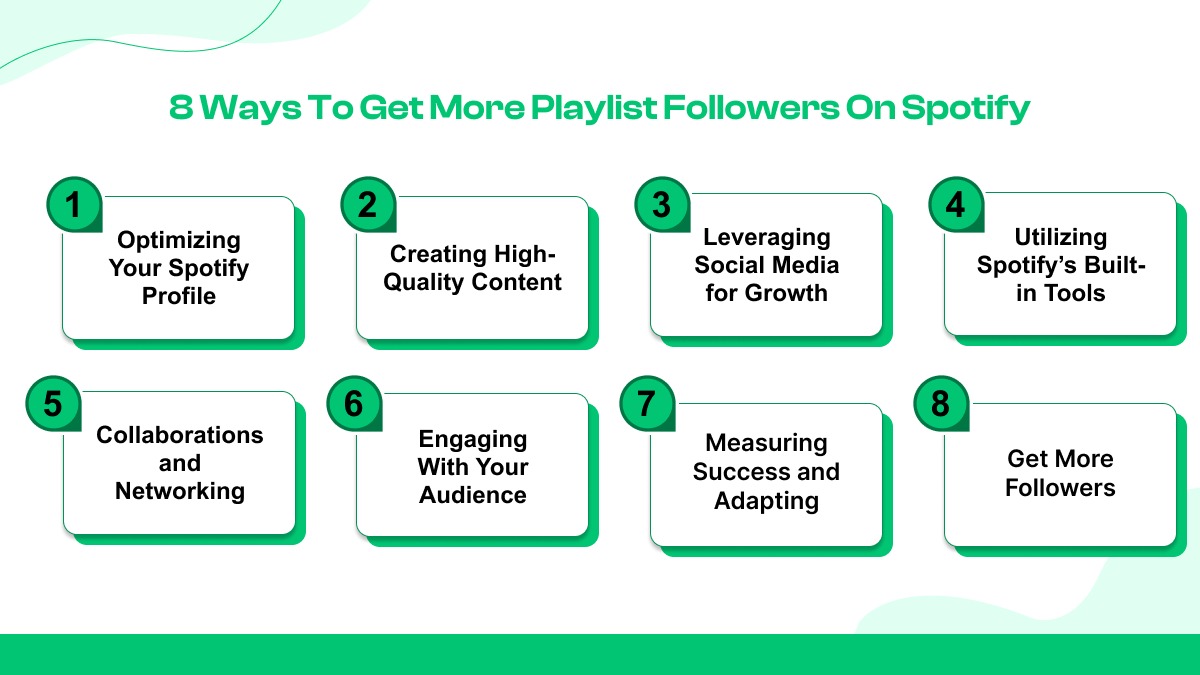
Now, let’s get to the main segment of this article.
Here are 8 ways that you can follow to earn more followers on Spotify-
1. Optimizing Your Spotify Profile
Artist profile setup (checklist)
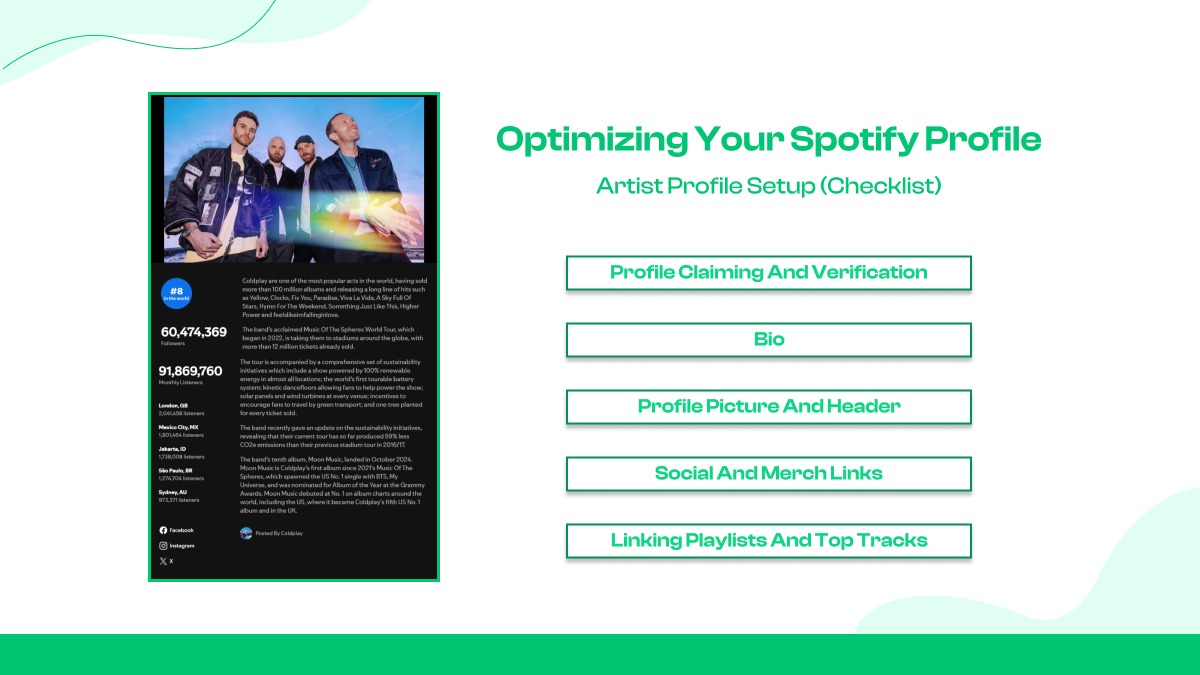
Profile Claiming and Verification: The first and foremost step is to claim your artist profile on Spotify and verify it.
Bio: Write a short bio for your profile in 2–3 sentences. You can also prepare a longer version, like a paragraph for press kits. While writing your artist bio, make sure to use plain language and tell your audience who you are, what you make, and what your music sounds like. Also, you can say a line about what they can expect next, like a new single, album, or tour.
Profile picture and header: Use a clean and high-quality image, following Spotify’s image guidelines, which show square avatar requirements and header size recommendations. Good images help build trust among your listeners.
Social and merch links: You can also add links to your socials like Instagram, Twitter, or YouTube, as well as links to merch or tickets on your Artists’ profile settings, so fans can connect elsewhere.
Linking playlists and top tracks: It will serve you well if you add an “Artist Pick” or featured playlist to the top of your profile. This will attract visiting listeners and prompt them to instantly follow a playlist or your whole profile.
A tidy and verified profile is more likely to convert casual listeners into followers, as it makes the artist look worth following.
Playlist branding (name, description, cover image)
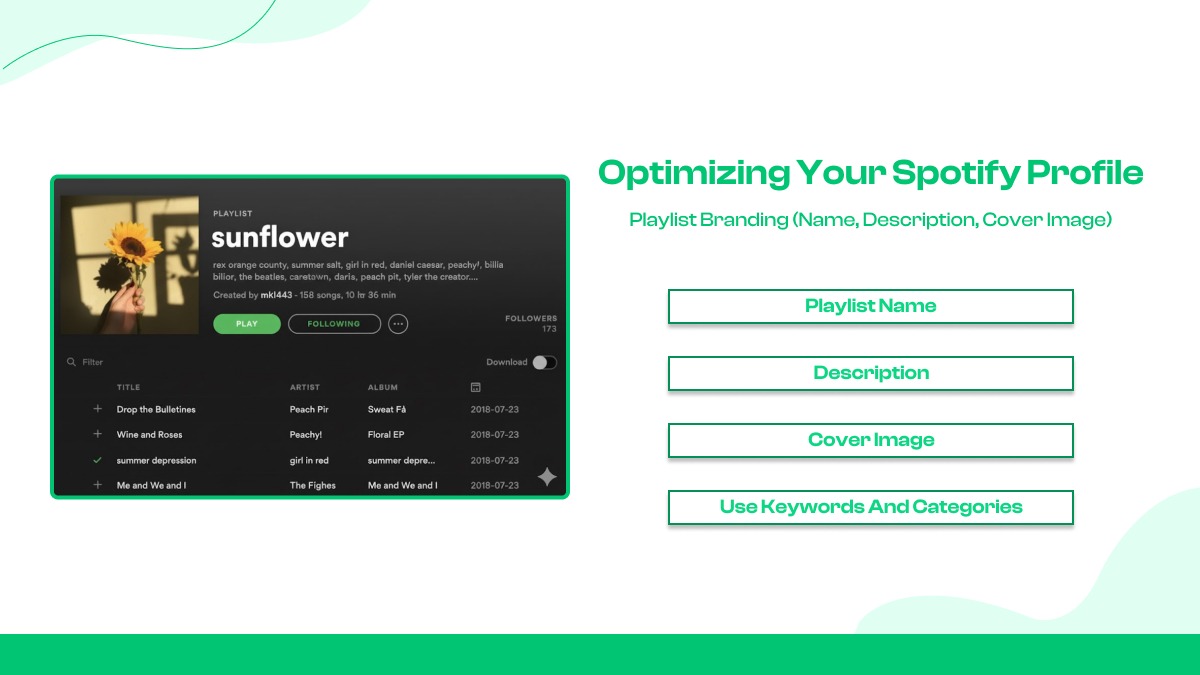
Playlist name: When you are making a playlist, try to keep the name as descriptive as possible, and make sure that it’s easily searchable. The best practice is to put the most important keyword first, such as “Chill Indie Music” or “lo-fi indie”. Avoid vague names like “My Faves 2025.”
Description: While describing your playlist, use the first couple of lines to summarize the mood and the listening context, such as “Calm focus music for studying or for coffee shops”. You can also add a short curator note, mentioning stuff like “curated by [name] and updated weekly”. These practices will help ensure that your playlist can be found easily on Spotify searches.
Cover image: Choose a clean picture to use as your cover image, and also make sure that it’s on-brand. Use square artwork and follow Spotify image limits. Keep the image under the maximum file size allowed by Spotify. Spotify now offers an in-app cover art maker; you can also use that. Go for high-resolution images, and use the recommended 300×300 px or higher.
Use keywords and categories: Include a genre, mood, or use case in the playlist’s title and description, such as “workout,” “study,” “vibes,” “rainy day”, etc. But don’t spam. Be natural and specific while using keywords.
Also, change your playlist artwork seasonally or when you’ve hit a milestone. Giving the playlist a fresh look from time to time may inspire followers, as well as outsiders, to click on it.
2. Creating High-Quality Content
Engaging music tracks (for artists)
The first thing you need to ensure is the quality of the tracks you release. Mastering, arrangement, and emotional clarity matter in this regard.
Tracks that manage to hold listeners, meaning low skip and high completion rate, are rewarded by the Spotify algorithm.
Release cadence: Many artists release singles every 4–8 weeks. Such regular release will give them extra opportunities to surface in Release Radar and algorithmic playlists. However, don’t compromise on quality. Pitch new music to Spotify editors at least seven days before release, so you can be eligible for editorial consideration.
Use visuals: You can also increase your saves, profile visits, and engagement by uploading small vertical visuals, such as canvas and short clips. Consistent and well-promoted releases will increase your chances of turning a listener into a follower, as they are more likely to return for the next drop.
Curated playlists (for curators)
Mix popular tracks with niche ones: Begin your playlist with a few familiar and well-known tracks that will hook new listeners. After they are hooked, introduce them to deeper and more interesting tracks. This will help you both with immediate engagement and long-term discovery.
Update cadence: Keep your playlists fresh, but don’t make them chaotic. Try to update your playlist weekly or biweekly. You can also announce updates on socials.
Track order and flow: You can open the playlist with strong and attention-grabbing songs. Proper sequencing matters for retaining listeners, and a higher retention helps a playlist appear before more users.
Credit & context: Tell listeners why the playlist exists through the description section, and ask them to hit “like” (the heart) or add to their library.
Cross-promotion
Collaborate with artists & curators: If your playlist features guest curators or recurring guest spotlights, it can gain followers from the guests’ audiences. Spotify encourages such collaborations. Also, artists often use these cross-promotions as a path to growth.
Swap shout-outs: Pair with owners of other playlists. Promote each other’s playlists on socials and in newsletter swaps.
Feature guest artists on curated lists: When guest artists feature on your curated list and share the playlist with their audience, it will help you effectively gain followers from their audiences.
3. Leveraging Social Media for Growth
Sharing Spotify links
Instagram Stories or Reels: Use the built-in “Share to Instagram” from Spotify or create short Reels showing the track and link in bio.
TikTok: TikTok has turned into one of the most powerful platforms for music discovery. Push short video clips on TikTok using your music or playlist snippets, and include a clear call to action (CTA), such as “link in bio” or a pinned comment. Independent studies, alongside TikTok’s reports, show the platform strongly helps increase streams for music.
Other platforms: Post 30–60 second teasers on your Facebook, X (formerly Twitter), or YouTube, and pin the Spotify artist or playlist link.
Engaging your audience
Contests & UGC: Encourage your followers to create a reel for Instagram or TikTok content by using a song from your playlist and tagging you. Do not depend on people streaming your tracks or following your profile as the sole entry mechanic. Invite people and incentivize instead, such as making offers like “tag for a chance to win a signed poster”.
Ask for shares: Asking your followers to share your work in a friendly manner always tends to work. Just say something like “If this playlist helped your study session, share it with a friend”, and it can do the trick.
Reward your fans’ loyalty: You can often do shout-outs, playlist features, or private Spotify listening sessions, which will make your superfans feel seen, and will likely bring others.
Paid social media campaigns
Boost your posts on social media platforms like Instagram or TikTok with a short vertical video and a link to the page of your artist profile or playlist. To do so, target people based on interest or artist affinity, which is like pulling audiences through similar artists on Spotify.
You can also use Spotify Ads & Ad Studio for running audio/video campaigns on the platform. An ad Studio campaign can start at a modest budget (Spotify notes campaign entry points and tools). If your goal is followers, run “click” or traffic objectives that bring users directly to your Spotify artist/playlist page.
4. Utilizing Spotify’s Built-in Tools
There are many built-in tools offered by Spotify, which are designed for artists and campaigns. Try using them when you are eligible to do so.
Marquee
Marquee is a full-screen data-driven recommendation system on Spotify, which appears to listeners who are likely to care about a new release. You can create the campaign from the “Campaigns” tab on Spotify for Artists.
Use this system to promote a new release to users who already show listening affinity. It will help turn casual listeners into followers or savers. This paid system works best if you already have some traction.
Discovery Mode
It’s an opt-in tool on Spotify where you select some priority tracks to be prioritized in personalized algorithmic playlists on Spotify, like Daylists. Discovery mode campaigns often help with uplifts, such as saves, playlist adds, or follows, as reported by Spotify itself.
However, this mode involves various royalty terms and is available only in certain markets and for eligible artists.
At the same time, it has drawn some industry criticism regarding fairness or transparency. If you consider using it, make sure to study more about its eligibility, performance reporting, and the royalty trade-offs before committing.
Showcase (and Campaign Kit)
The Campaign Kit on Spotify combines several tools, like playlist pitching (free), Marquee, Discovery Mode, and Showcase (sponsored Home placements). You can use it to go for both organic pitching and targeted paid pushes, which can translate to better follower conversion.
Check your Campaigns tab in Spotify for Artists, see what you’re eligible for, and test one small Marquee or Ad Studio campaign to measure changes.
5. Collaborations and Networking
A great way to get your song or playlist featured in related blogs or curator pages is to partner with influencers, playlist curators, and other artists. Such collaborations are rewarded by Spotify’s editorial and network effects.
Guest playlists are also amazing for your promotion. For that, invite other curators to co-curate a playlist for a month and ask them to promote it. Followers often carry over when the curator shares.
Also, try leveraging industry events and music communities. Use LinkedIn groups, Discord servers, and music Slack communities to build relationships.
Overall, collaborations can do wonders for you as an artist or curator, as they give you access to a real audience, not fake numbers.
6. Engaging With Your Audience (sustain the relationship)
While Spotify doesn’t allow public comments, your fans may still find ways to reach out to you through DMs or public comments on your social posts. Make sure that you reply to their messages and social comments, as quick and humane replies help build loyalty.
Also, while engaging your followers on social media, ask them to share their favorite tracks. You can just use a “Share your pick” prompt in Instagram Stories or a pinned Tweet. This will increase your organic reach.
Don’t forget to reward your loyal listeners. To do so, use Fan Support, exclusive playlist invites, early access to songs or Clips, or shout-outs in playlists. Spotify’s Fan Support and Artist Pick features help you highlight exclusives and fundraising links on profile pages.
7. Measuring Success and Adapting
Use the analytics of Spotify for Artists to track your followers, saves, playlist adds, monthly listeners, and audience segments. Not just raw streams.
Focus on the number of saves and playlist adds, as well as how many listeners have turned into your followers.
Key metrics to track-
Find out what helps with follower growth and double down on it. Also, use Campaign Kit reporting and Ad Studio analytics for paid tests.
8. Get More Followers On Spotify With Socialplug
Growing your Spotify followers is not just about uploading tracks. It’s rather about creating an experience that listeners will want to return to. A set of actions, ranging from optimizing your profile to promoting your playlists across different platforms, will help you build a loyal audience.
You have to make your profile stand out and keep your playlists and releases fresh. You also need to update playlists consistently. Social media storytelling can also do wonders for you. Don’t forget, fan interactions can turn casual listeners into loyal followers or fans.
However, no matter how much effort you put in or how good your music tracks are, it can always be difficult to grow your followers on Spotify. And a little push in this regard can help you go a long way.
You can try out our services that can help you gain followers for your artist profile or playlists.
Worried about your meager number of monthly listeners? Socialplug can help you increase that too, which will help build visibility and credibility, which in turn will help you gain a lot more organic listeners and followers over time.
With Socialplug’s services, you can-
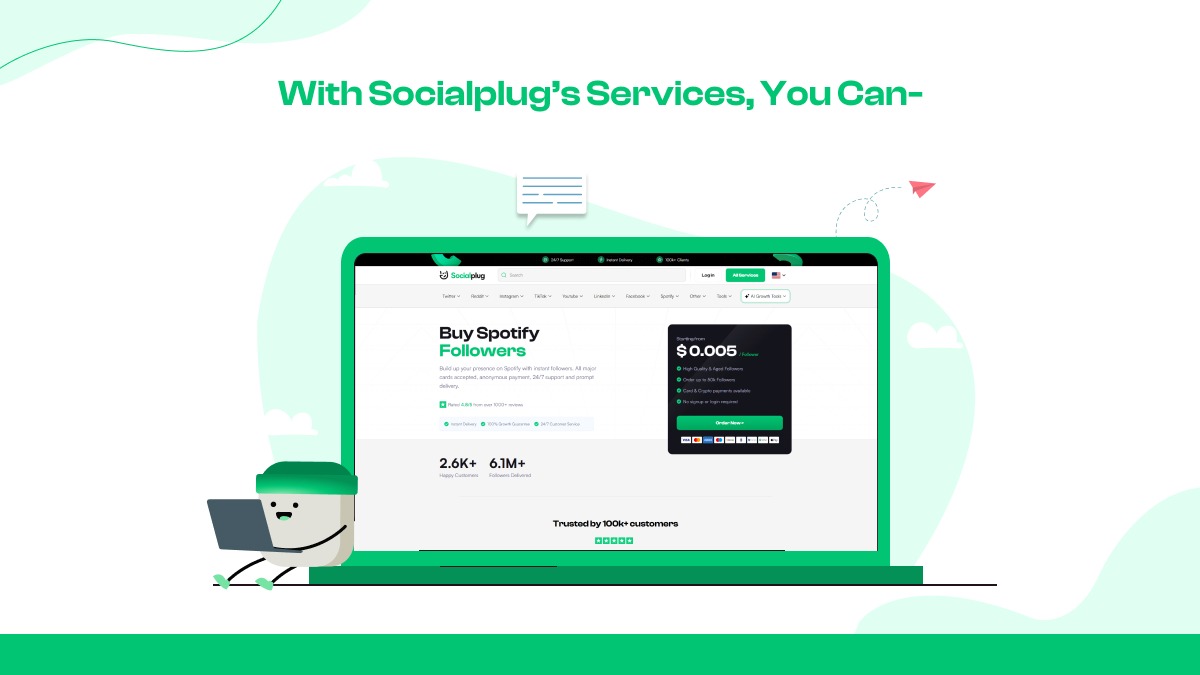
Finally, make sure to adapt to trends and be consistent in your efforts. The platform evolves constantly, so staying flexible, authentic, and persistent is key.
Over time, your steady efforts build not only your follower count but also a genuine, engaged community around your sound
Frequently Asked Questions
What is the 30-second rule on Spotify?
The 30-second rule refers to Spotify counting a play only after a listener has streamed a track for at least 30 seconds. This metric affects your song’s engagement rate and your eligibility for monetization.
Can artists see their followers on Spotify?
Yes. Through the Spotify for Artists dashboard, artists can see their total number of followers and detailed insights about listener demographics, top locations, and song performance. However, Spotify doesn’t currently show individual followers, only aggregate data.
How to influence the Spotify algorithm?
Consistent engagement is rewarded by Spotify’s algorithm. Encourage your listeners to save your songs, add them to their playlists, and follow your profile. Also, release and promote music regularly. All these will help influence the algorithm.
How does Spotify pay artists?
Spotify pays rights holders, not artists directly, based on total streams. The platform earns its revenue from ads and subscriptions, then allocates payments proportionally based on the share of total streams for each track. Artists receive their cut through their label or distributor.
How to get 1,000 followers on a playlist?
Use a catchy title, detailed description, and custom cover art, reflecting your playlist’s mood. Also, focus on consistent curation, strong branding, and organic promotion. You can also get Socialplug’s help with that.
How many Spotify plays does it take to make $1,000?
Earnings vary by region and type of listener (premium vs. free). On average, Spotify pays between $0.003 and $0.005 per stream, meaning an artist would need around 200,000 to 300,000 plays to make roughly $1,000.
Can you buy listeners on Spotify?
Yes. There are services like Socialplug, from which you can buy listeners.
Are monthly listeners the same as followers?
No. Monthly listeners are the unique users who streamed your music in the past 28 days. Followers are users who’ve chosen to stay updated on your future releases.






.svg)
.svg)




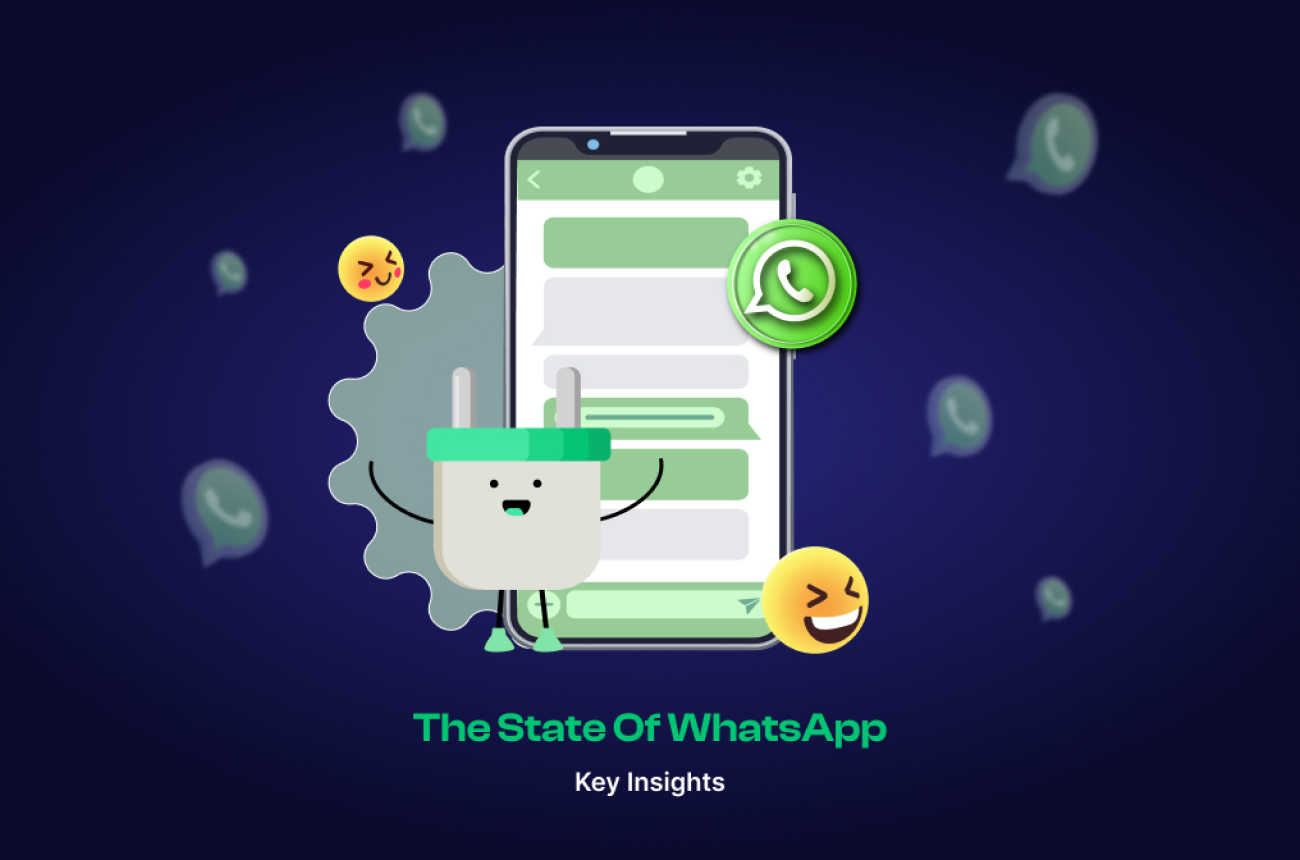



0 Comments
Great tips! I never realized how much engagement impacts growth more than just posting frequently. I've been focusing only on content, but now I see how interacting with my audience can make a difference. Time to step up my strategy!
Super helpful article! I always thought Facebook Groups were just for discussions and never really considered them as a tool for growing followers. The idea of actively engaging and sharing valuable content in relevant groups makes so much sense. I'll definitely start participating more and see how it impacts my page. Thanks for the great advice!